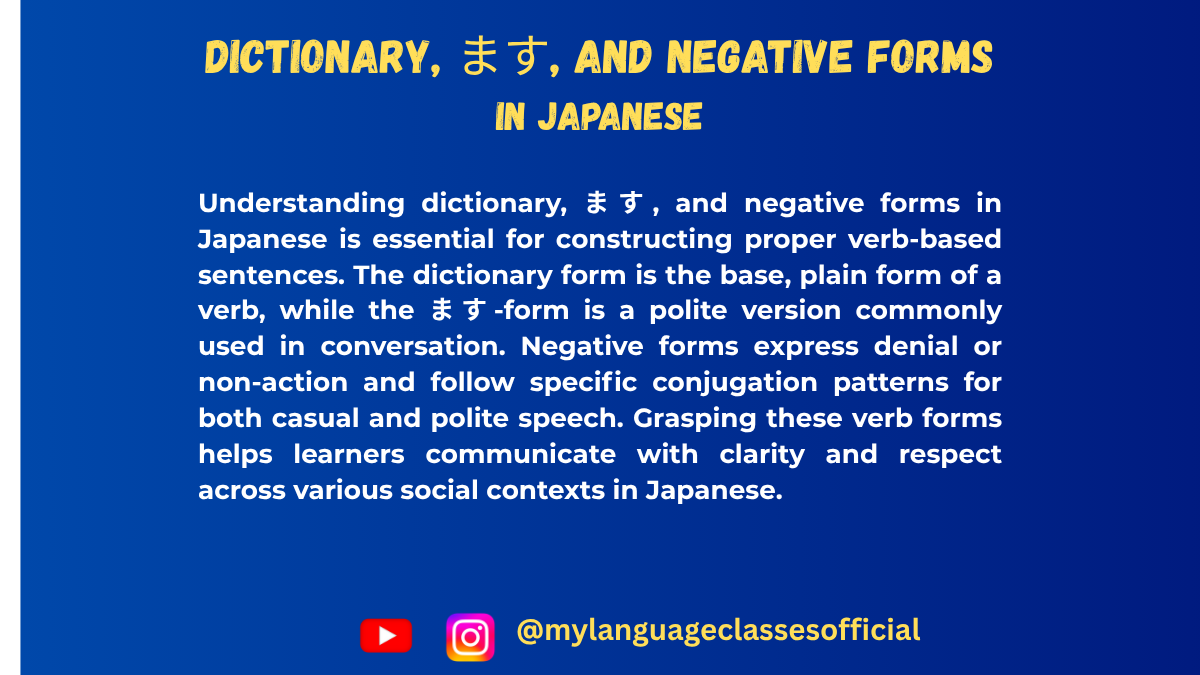Your cart is currently empty!
Tag: Japanese Polite Form
-

How to Use Verb Forms (Dictionary, ます,ません) in Japanese | My Language Classes
Japanese Verb Conjugation: Dictionary, ます, and ません form
When learning Japanese, verbs are a foundational aspect of the language, and understanding how to conjugate them correctly is crucial. In this blog post, we’ll explore how to express the present/future tense in Japanese using different verb forms:
- Dictionary Form (辞書形, jisho-kei)
- ます Form (polite form)
- Negative Form
We’ll also break down how to transform the dictionary form into the ます form and negative form for all three groups of Japanese verbs.
The Basics of Verb Groups
Japanese verbs fall into three main groups:
Group 1 (五段動詞 – Godan Verbs)
These verbs typically end with an -u sound (う, く, す, etc.) in their dictionary form, e.g., 書く (kaku), “to write.”
Group 2 (一段動詞 – Ichidan Verbs)
These verbs end with -eru or -iru in their dictionary form, e.g., 食べる (taberu), “to eat.”
Group 3 (Irregular Verbs)
Only two verbs fall in this category: する (suru), “to do,” and 来る (kuru), “to come.”
1. The Dictionary Form (辞書形)
The dictionary form is the standard form of the verb, used in casual speech or when looking up words in a dictionary.
Examples:
- Group 1: 飲む (nomu) – “to drink”
- Group 2: 食べる (taberu) – “to eat”
- Group 3: する (suru) – “to do”
The dictionary form indicates present or future tense depending on the context. For example:
- 水を飲む。(Mizu o nomu.) – “I drink water.”
- 明日映画を見る。(Ashita eiga o miru.) – “I will watch a movie tomorrow.”
2. The ます Form (Polite Form)
The ます form is the polite version of the dictionary form, commonly used in formal conversations.
How to Form the ます Form:
Group 1 Verbs:
Change the final -u sound of the verb to the corresponding -i sound, and add ます.
- 書く (kaku) → 書きます (kakimasu) – “to write”
- 飲む (nomu) → 飲みます (nomimasu) – “to drink”
Group 2 Verbs:
Remove the final る and add ます.
- 食べる (taberu) → 食べます (tabemasu) – “to eat”
- 見る (miru) → 見ます (mimasu) – “to see/watch”
Group 3 Verbs (Irregular):
- する (suru) → します (shimasu) – “to do”
- 来る (kuru) → 来ます (kimasu) – “to come”
Examples in Sentences:
- 手紙を書きます。(Tegami o kakimasu.) – “I will write a letter.”
- 日本語を勉強します。(Nihongo o benkyou shimasu.) – “I study Japanese.”
3. The Negative Form
The negative form is used to express “not do” or “will not do.”
How to Form the Negative:
Group 1 Verbs:
Change the final -u sound of the verb to the corresponding -a sound and add ない.
- 書く (kaku) → 書かない (kakanai) – “not write”
- 飲む (nomu) → 飲まない (nomanai) – “not drink”
Group 2 Verbs:
Remove the final る and add ない.
- 食べる (taberu) → 食べない (tabenai) – “not eat”
- 見る (miru) → 見ない (minai) – “not see/watch”
Group 3 Verbs (Irregular):
- する (suru) → しない (shinai) – “not do”
- 来る (kuru) → 来ない (konai) – “not come”
Examples in Sentences:
- 何も書かない。(Nani mo kakanai.) – “I don’t write anything.”
- ご飯を食べない。(Gohan o tabenai.) – “I will not eat the meal.”
Quick Reference Table
Verb Group Dictionary Form ます Form Negative Form Group 1 書く (kaku) 書きます (kakimasu) 書かない (kakanai) Group 2 食べる (taberu) 食べます (tabemasu) 食べない (tabenai) Group 3 する (suru) します (shimasu) しない (shinai) Group 3 来る (kuru) 来ます (kimasu) 来ない (konai)
Practice Makes Perfect!
Understanding Japanese verb conjugation is essential to mastering the language. Practice by converting verbs you encounter into different forms, and try using them in sentences. With consistent effort, these forms will become second nature.
Happy learning, and がんばってください (ganbatte kudasai)!
If you enjoyed this lesson, be sure to check out more posts like this on my blog at My Language Classes. Don’t forget to subscribe my YouTube channel and follow me on Instagram for the latest language learning tips and lessons. Leave a comment below to share your thoughts, or ask any questions you have about nouns.
Happy learning! 😊
